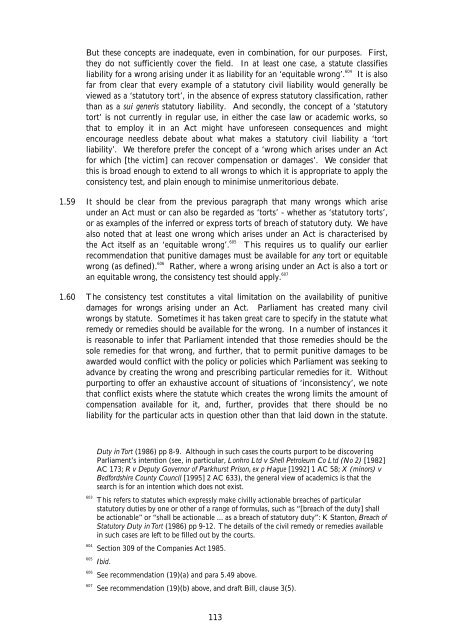Aggravated, Exemplary and Restitutionary ... - Law Commission
Aggravated, Exemplary and Restitutionary ... - Law Commission
Aggravated, Exemplary and Restitutionary ... - Law Commission
Create successful ePaper yourself
Turn your PDF publications into a flip-book with our unique Google optimized e-Paper software.
But these concepts are inadequate, even in combination, for our purposes. First,<br />
they do not sufficiently cover the field. In at least one case, a statute classifies<br />
liability for a wrong arising under it as liability for an ‘equitable wrong’. 604<br />
It is also<br />
far from clear that every example of a statutory civil liability would generally be<br />
viewed as a ‘statutory tort’, in the absence of express statutory classification, rather<br />
than as a sui generis statutory liability. And secondly, the concept of a ‘statutory<br />
tort’ is not currently in regular use, in either the case law or academic works, so<br />
that to employ it in an Act might have unforeseen consequences <strong>and</strong> might<br />
encourage needless debate about what makes a statutory civil liability a ‘tort<br />
liability’. We therefore prefer the concept of a ‘wrong which arises under an Act<br />
for which [the victim] can recover compensation or damages’. We consider that<br />
this is broad enough to extend to all wrongs to which it is appropriate to apply the<br />
consistency test, <strong>and</strong> plain enough to minimise unmeritorious debate.<br />
1.59 It should be clear from the previous paragraph that many wrongs which arise<br />
under an Act must or can also be regarded as ‘torts’ - whether as ‘statutory torts’,<br />
or as examples of the inferred or express torts of breach of statutory duty. We have<br />
also noted that at least one wrong which arises under an Act is characterised by<br />
the Act itself as an ‘equitable wrong’. 605<br />
This requires us to qualify our earlier<br />
recommendation that punitive damages must be available for any tort or equitable<br />
wrong (as defined). 606<br />
Rather, where a wrong arising under an Act is also a tort or<br />
an equitable wrong, the consistency test should apply. 607<br />
1.60 The consistency test constitutes a vital limitation on the availability of punitive<br />
damages for wrongs arising under an Act. Parliament has created many civil<br />
wrongs by statute. Sometimes it has taken great care to specify in the statute what<br />
remedy or remedies should be available for the wrong. In a number of instances it<br />
is reasonable to infer that Parliament intended that those remedies should be the<br />
sole remedies for that wrong, <strong>and</strong> further, that to permit punitive damages to be<br />
awarded would conflict with the policy or policies which Parliament was seeking to<br />
advance by creating the wrong <strong>and</strong> prescribing particular remedies for it. Without<br />
purporting to offer an exhaustive account of situations of ‘inconsistency’, we note<br />
that conflict exists where the statute which creates the wrong limits the amount of<br />
compensation available for it, <strong>and</strong>, further, provides that there should be no<br />
liability for the particular acts in question other than that laid down in the statute.<br />
Duty in Tort (1986) pp 8-9. Although in such cases the courts purport to be discovering<br />
Parliament’s intention (see, in particular, Lonhro Ltd v Shell Petroleum Co Ltd (No 2) [1982]<br />
AC 173; R v Deputy Governor of Parkhurst Prison, ex p Hague [1992] 1 AC 58; X (minors) v<br />
Bedfordshire County Council [1995] 2 AC 633), the general view of academics is that the<br />
search is for an intention which does not exist.<br />
603 This refers to statutes which expressly make civilly actionable breaches of particular<br />
statutory duties by one or other of a range of formulas, such as “[breach of the duty] shall<br />
be actionable” or “shall be actionable ... as a breach of statutory duty”: K Stanton, Breach of<br />
Statutory Duty in Tort (1986) pp 9-12. The details of the civil remedy or remedies available<br />
in such cases are left to be filled out by the courts.<br />
604 Section 309 of the Companies Act 1985.<br />
605 Ibid.<br />
606 See recommendation (19)(a) <strong>and</strong> para 5.49 above.<br />
607 See recommendation (19)(b) above, <strong>and</strong> draft Bill, clause 3(5).<br />
113
















